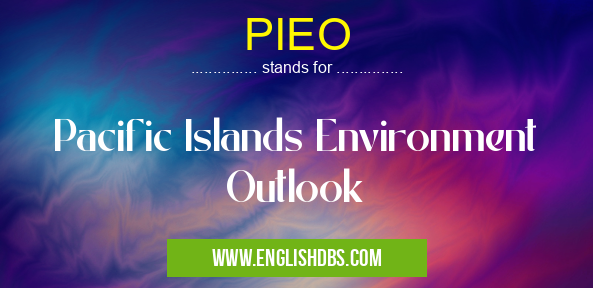What does PIEO mean in UNCLASSIFIED
PIEO stands for Pacific Islands Environment Outlook. It is an environmental assessment developed and published by the Secretariat of the Pacific Regional Environment Programme (SPREP), in partnership with regional stakeholders, to assess the state of the environment in 22 countries and territories in the Pacific region. The PIEO provides a comprehensive baseline of information to support decision-making, resource management, and planning for more sustainable futures at all levels of governance. This report serves as a cornerstone for environmental monitoring within SPREP’s member states and its territory governments.

PIEO meaning in Unclassified in Miscellaneous
PIEO mostly used in an acronym Unclassified in Category Miscellaneous that means Pacific Islands Environment Outlook
Shorthand: PIEO,
Full Form: Pacific Islands Environment Outlook
For more information of "Pacific Islands Environment Outlook", see the section below.
Definition
Pacific Islands Environment Outlook (PIEO) is an environmental assessment that provides an overview of the state of environment in 22 countries and territories in the Pacific region. It was developed and published by the Secretariat of the Pacific Regional Environment Programme (SPREP). The PIEO includes information on various topics related to marine resources, land use, water, biodiversity, climate change and many more issues related to environment sustainability in this region. The main aim of this report is to provide a comprehensive baseline data that can help in making decisions that could improve resource management, promote environmental conservation and efficient planning for sustainable future outcomes at multiple levels of government.
Benefits
The PIEO provides a comprehensive view on island ecosystems which enables local communities to plan ahead for future needs. It gives stakeholders -including policy makers – a means to evaluate current trends, impacts and threats caused by climate change or other human activities; thus technology gaps can be identified and addressed accordingly. The analysis provided has also helped create new strategies for sustainable tourism development which considers ecological balance along with socioeconomic goals. Moreover, it has enabled decision-makers to identify appropriate ways to reduce waste generation by looking into every aspect from generating waste until its disposal into landfills or treatment sites. It also gives valuable insight on how communities can incorporate environmentally friendly habits into their lifestyle such as recycling or using organic materials for farming purposes etc.. In addition, it allows us to understand our oceans well enough that it enables people to conserve precious marine resources while simultaneously providing nutritious food access for those living near coastal areas.
Essential Questions and Answers on Pacific Islands Environment Outlook in "MISCELLANEOUS»UNFILED"
What is the Pacific Islands Environment Outlook (PIE0)?
The Pacific Islands Environment Outlook (PIE0) is a report produced by the Secretariat of the Pacific Regional Environment Programme (SPREP), which provides an updated assessment of the environment in the Pacific Islands region. It covers a range of topics from air pollution to terrestrial and marine ecosystems, as well as human health issues related to environmental degradation. PIE0 aims to provide an overview of the current state of the environment in the region, identifying both threatening processes and those opportunities that exist for improvements in environmental sustainability.
What are some threats highlighted by PIE0?
The PIE0 Report identified several major threats to environmental sustainability in the region, including unsustainable development, increasing urbanisation, climate change and sea-level rise, biodiversity loss, pollution from land-based activities and overfishing. All these factors have adversely impacted various ecosystem services such as water resources, coasts and reefs.
What actions does PIE0 recommend?
PIE0 outlines a range of recommendations for addressing these threats. These include enhancing regional coordination on policy development; developing national strategies and programs for managing resources sustainably; building capacity in environmental monitoring; improving access to data; encouraging public participation in decision making; promoting sustainable production practices; expanding renewable energy use; protecting critical habitats; strengthening institutional frameworks and reducing greenhouse gas emissions.
What countries are covered by the PIE0 report?
The PIE0 report covers 15 Pacific Island countries along with Australia and New Zealand. This includes Fiji, Solomon Islands, Palau, Tuvalu, Tonga, Micronesia, Marshall Islands, Kiribati and more.
How often is the PIE0 report published?
The first edition was developed in 2008 with subsequent editions being released every four years since then. The latest report is due to be released later this year.
Where can I find more information about PIE0?
More information about PIE0 can be found on SPREP's website at www.sprep.org or by contacting their offices directly via email at [email protected] or phone on +684 2397777 . You can also find out more about each country’s respective contributions to global environmental sustainability through SPREP’s Sustainable Development Goals toolbox located here https://www.sprep-sdgtoolbox-pacificcentreforenvironmentandsustainablesolutionsdevelopment-unescosdgtoolboxsteinhardtnyuedu/.
What role do Small Island Developing States play in global environmental sustainability?
Small Island Developing States play an important role in global environmental sustainability as they tend to have fragile eco-systems where small changes can result in big impacts due to their limited natural resources and exposure to climate risks such as sea-level rise and extreme weather events associated with Climate Change. As members of UN conventions such as UNCLOS (United Nations Convention on Law of Sea) they are also responsible for protecting their exclusive economic zones from overfishing affecting many surrounding nations who depend on healthy fisheries for food security and livelihoods.
Final Words:
In conclusion, PIEO is essential in monitoring the health of our planet's life-support systems - including air quality, coral reefs health as well as fisheries resources through which nature supports human livelihoods in this region – which makes it even more crucial today than ever before; given our current environmental uncertainty momentous challenges pose ahead of us regarding how we might sustainably manage our planet’s resources responsibly so these valuable ecosystems are preserved not only now but also for generations far down the line from us.
